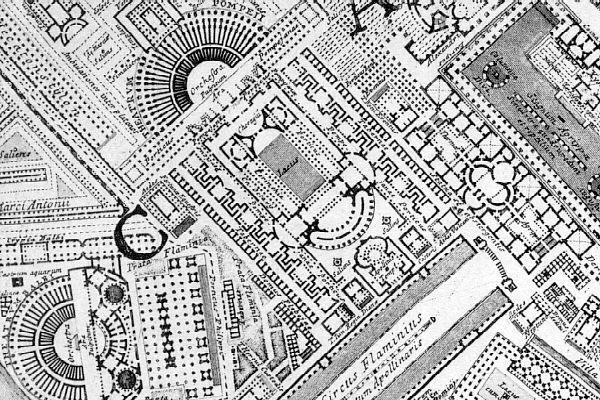

| |
Catalogo:
Porticus Pompejanae (Portico Pompeo.) «Vitruv. nel lib. 5, al cap. 9, Appian. della guerra civile.» near the Theater of Pompey
The porticus Pompei, built in 55 B.C. by Pompeius, at the same time as his theater. The porticus adjoined the scena of the theatre and enclosed a large rectangular court, its purpose being to provide shelter for the spectators in case of sudden showers. The same provision was made in the case of the theater of Marcellus, but no trace of that porticus has been found. The porticus Pompei suffered in the conflagrations which destroyed the theater, and was restored by Domitian; in the reign of Diocletian, by the prefect of the city, Aulus Helvius Dionysius; and by Arcadius and Honoritis in 418-420 A.D. Helvius called one part of the restored structure porticus Iovia and the other porticus Herculea, in honor of the emperors Diocletian and Maximian. The central area was laid out as a garden with shady walks, and contained many works of art. At some point in the porticus was an exedra, called the curia Pompei, in which Caesar was murdered. The statue of Pompeius which stood there was removed by Augustus, who walled up the curia as a locus sceleratus. (Platner)
Porticus Pompeiana; see Vitruv. v. 9. 1. Outside the theater, at the back of the scena, was a very large and magnificent building supported by several parallel ranges of columns, forming a great Porticus or court, with an open area in the center. planted with avenues of sycamore trees and decorated with fountains and rows of statues in marble and gilt bronze. This Porticus Pompeii was also known as the Hecatostylon or "Hall of the hundred columns"; it is shown on three fragments of the Marble Plan, one of which is inscribed with the word [HECA]TOSTYLON. (Middleton)
Vincenzo Fasolo, "The Campo Marzio of G. B. Piranesi".
2691a
2691d
1956
|